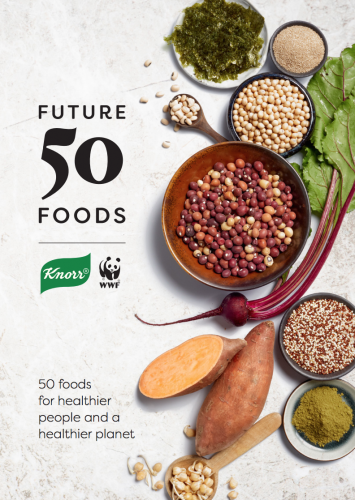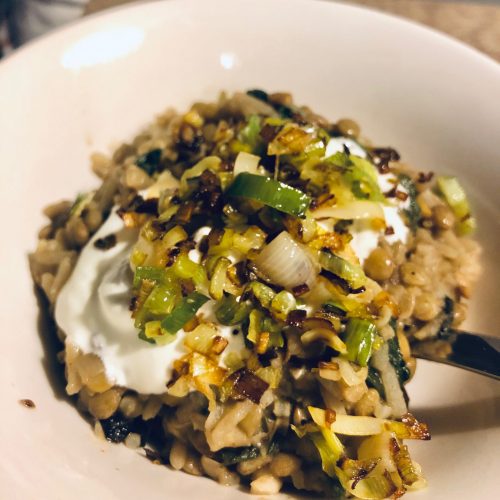Humans are a part of Earth’s natural systems and we depend on those systems to survive, but our actions can also negatively affect the health of our planet. Fortunately, science from many fields is helping us understand the changes we can make to lessen our impact on the environment. Through the “Action of the Month,” we plan to share what sustainable strategies we’re trying and explore some of the science behind them.
 In April, I was inspired to cook more lentils by the release of a new campaign by the World Wide Fund for Nature and Knorr Foods called “Future 50 Foods: 50 Foods for Healthier People and a Healthier Planet.”
In April, I was inspired to cook more lentils by the release of a new campaign by the World Wide Fund for Nature and Knorr Foods called “Future 50 Foods: 50 Foods for Healthier People and a Healthier Planet.”
The report begins by explaining some of the negative impacts conventional staples, such as wheat, rice, corn, and beef, can have on human health and the environment. These include reduced biodiversity around areas where only a few crops are planted and high greenhouse gas emissions from meat, dairy, and egg production.
The WWF goes on to recommend 50 foods that can help address some of these impacts and enhance human health, particularly as the worldwide human population continues to grow. For foods to make the list, they had to have a reduced environmental impact and high nutritional value, taste good, and be accessible, acceptable, and affordable.
Some of these 50 future foods were totally new to me, and many are not yet easily available for purchase in the United States. One item did catch my eye, particularly as I had previously heard praise for its nutritional and environmental benefits– lentils!
According to the report, lentils are high in protein, don’t require much water to grow, and have a dramatically reduced carbon footprint compared to other popular protein sources like pork and beef. Lentils were also one of the first crops cultivated by humans, giving them an added cultural significance.

Ready to hop on board the lentil train, my family and I tried out multiple recipes over the course of several weeks. I found that lentils were flavorful, versatile, and exceptionally budget friendly! The three dishes we have enjoyed the most so far are a hearty lentil soup, a flavorful mujadara, and an incredibly tasty lentil gumbo. The gumbo recipe also contains okra, which happens to be another one of WWF’s Future 50 foods! Links to these recipes are listed at the bottom of this post.
Cooking with lentils is both easy and cost-effective, but what environmental benefit can it truly have?
I decided to investigate this question by exploring how eating lentils can reduce my carbon footprint and lessen my contribution to our warming climate. Using data from a 2017 scientific study on the greenhouse gas emissions produced from growing and processing different foods, I calculated what it would mean to replace one beef-based meal with a lentil-based meal each week. This study reports greenhouse gas emission values using the unit ‘carbon dioxide equivalent,’ which accounts for all the different greenhouse gasses produced throughout the food growth and production processes.
For a single individual, swapping one beef-based meal for a lentil-based meal each week can prevent 122 kilograms, or about 269 pounds, of carbon dioxide equivalent from being released into the atmosphere annually. Using a calculation provided by the US EPA, that’s the equivalent of driving 303 fewer miles throughout the course of a year. That may not seem like much, but if all 21 million Floridians make the same swap, that adds up to preventing 2.5 billion kilograms, or 5.5 billion pounds, of carbon dioxide equivalent from being released. This is the same as Floridians driving 6.3 billion fewer miles each year.
In other words, regularly swapping meat-based protein for lentils could play a role in reducing some of climate change’s predicted impacts on Florida such as sea-level rise and increased tropical storm intensity.
If lentils aren’t your thing, there are 49 other WWF-recommended foods to explore! You can read more about the 50 Future Foods in this great piece by Eleanor Beardsley of National Public Radio.
Recipes:
Instant Pot Lentil Gumbo, by Cotter Crunch of SideChef: https://www.sidechef.com/recipes/7546/instant_pot_lentil_gumbo/
Instant Pot Golden Lentil and Spinach Soup, by Kare of Kitchen Treaty: https://www.kitchentreaty.com/instant-pot-vegan-golden-lentil-spinach-soup/
One Pot Mujadara with Leeks and Greens, by Melissa Clark of New York Times Cooking: https://cooking.nytimes.com/recipes/1014804-one-pot-mujadara-with-leeks-and-greens and http://fullbellyfarm.com/recipes/one-pot-mujadara-leeks-greens/ (open access version).
About the Author
 Sadie Mills is a coordinator and environmental educator for TESI. She manages programs and events that support TESI’s mission of educating Floridians about the state’s natural systems and the threats they face.
Sadie Mills is a coordinator and environmental educator for TESI. She manages programs and events that support TESI’s mission of educating Floridians about the state’s natural systems and the threats they face.